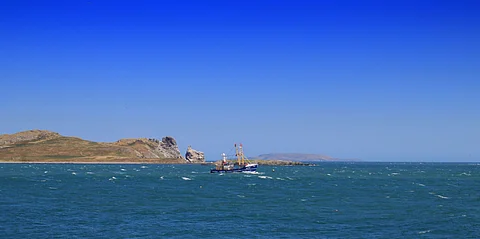

A fishing trawler passing the uninhabited island of Ireland's Eye off Howth Harbour in Dublin Bay, Ireland.
Photo: Adobe Stock.
In a joint statement from the Minister for Agriculture, Food and the Marine, Martin Heydon, and Minister of State with responsibility for Fisheries, Timmy Dooley, the Government of Ireland announced its intention to place certain restrictions on trawling activity by large vessels inside the six nautical mile zone and the baselines.
Following these restrictions, trawling activity - that is, the operation of trawl or seine nets - by fishing vessels over 18 metres in length overall inshore waters inside the six nautical mile zone and the baselines will be prohibited from 1 October 2026.
Nevertheless, between October 1, 2025, and September 30, 2026, a limited total allowable catch (TAC) of 2,000 tonnes of sprat will be allowed within the six nautical mile zone and the baselines for these same vessels over 18 meters length overall, although they will require an authorization.
"This is a matter of significant public interest, and the decision has been preceded by an extensive public consultation which has been considered carefully. I am satisfied that this is the right thing to do for the preservation of sustainable fisheries in our inshore waters," said Agriculture, Food and the Marine head Martin Heydon, commenting on the announcement.
"There is a compelling case for excluding trawling by large vessels in coastal waters inside six nautical miles and the public have spoken," added Minister of State with responsibility for Fisheries, Timmy Dooley.
As noted by Heydon and Dooley, this decision about trawling activity has been taken after a public consultation in which the proposal document was accompanied by scientific analysis provided by the Marine Institute and Bord Iascaigh Mhara, respectively.
In total, 5,574 submissions to the public consultation were received, including from industry representative bodies, state agencies, environmental NGOs, and the public, and the 5,482 received by the deadline were analyzed.
Of these, a total of 5,169, or 94% of the responses, indicated that, at a minimum, their preferred option was that all fishing vessels over 18 meters should be excluded from trawling within the six nautical mile limit and baselines.
In addition, 78% of the participants - 4,302 responses - expressed a preference for the measures to be fully implemented once the decision was made, while 7% - 357 responses - preferred a gradual implementation, and 15% - 823 responses - expressed no preference as to the timing.
However, although the majority were inclined that the measures would be introduced in full effect, Minister of State Dooley said he was acutely aware that fishing vessel owners would have planned their activities for the rest of the year and, indeed, also up to 2026. For that reason, as mentioned above, the Government of Ireland has decided to introduce them in a phased way, allowing for a one-year transition period from October 1.
"This will allow a period of adjustment for all affected vessels who have planned fishing activities inside the six nautical mile zone during the period. I am asking BIM to offer affected vessel owners technical assistance to adjust their trawling activity away from the six nautical mile zone by the end of the transition process," said Minister Dooley.
Dooley also said he was aware of the opportunity these measures provide for small-scale fishermen, and that he is confident it will help restore links between local fishery resources, local fleets, and local economies.
"Our inshore fleet is a vital part of our coastal and often rural communities and depends on fishing resources within the six nautical mile zone. To reiterate, this decision helps deliver on the Programme for Government commitments and supports families in these coastal communities," the Irish Minister of State with responsibility for Fisheries continued.
Recently announced, the 2025 Programme for Government commits to "maintain support for the inshore fishing sector" and "promote the sustainability of fish stocks, while ensuring sufficient supply of species to allow fishers into the future derive a fair return."
Likewise, Timmy Dooley also said that these actions can deliver wider ecosystem benefits, including essential fish habitats, and went on to say that he sees this new policy as an important reflection of Ireland's commitment to the UN Sustainable Development Goals, in particular SDG 14, Life Below Water, Target 14. B of which relates to access for small-scale artisanal fishers to marine resources.
Ireland thus joins the trend seen in other European countries such as the UK, which wants to extend the ban on bottom trawling, or Sweden, which has also taken measures to protect the Baltic Sea by banning bottom fishing in marine protected areas.
Meanwhile, in June, marine scientists from around the world have signed an open letter to the United Nations (UN) urging the protection of vulnerable marine ecosystems from bottom fishing and, just this month, in France, the ocean advocacy NGO BLOOM has filed a formal legal notice to the French state, demanding immediate action to stop bottom trawling.
